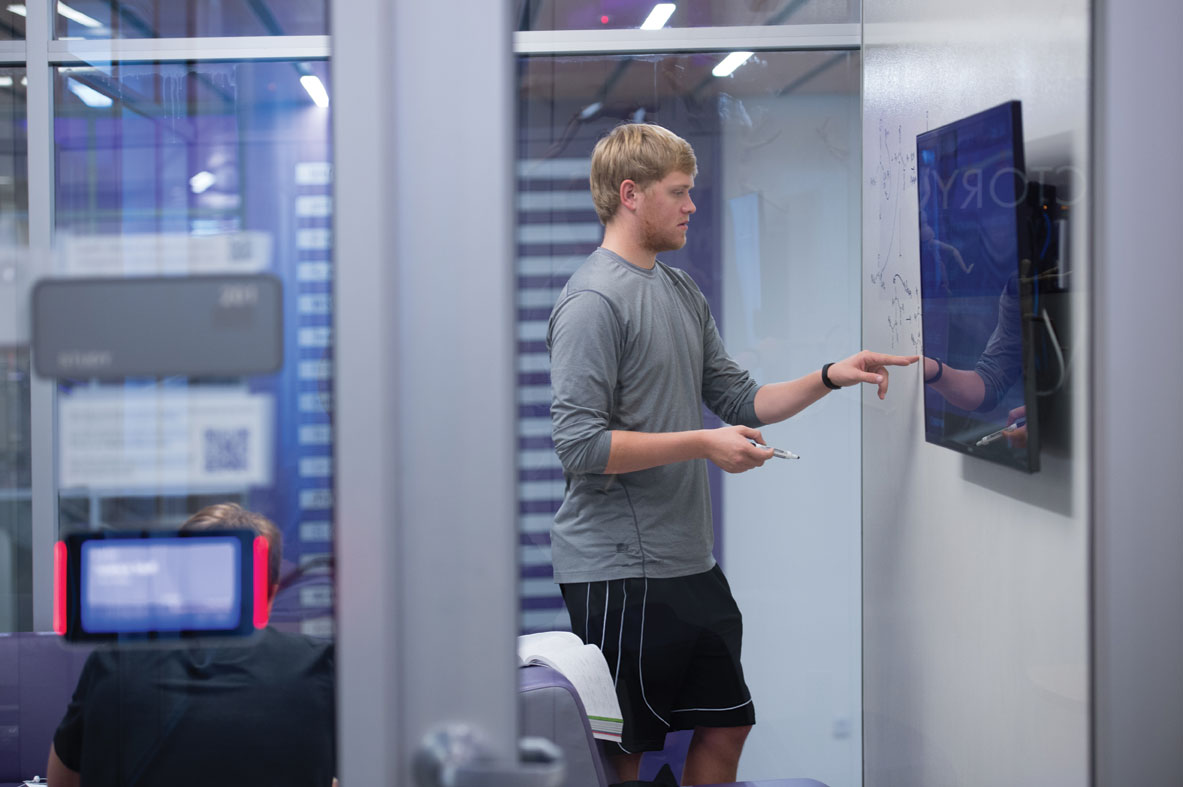The writing
on the wall

Nearly every wall is writable in Rees-Jones Hall, where study rooms are a hot commodity. (Photo by Leo Wesson)
The writing
on the wall
WHEN BUILDING PLANNERS were sketching concepts for Rees-Jones Hall, an early idea was to have writable surfaces everywhere. The thinking went: The more places students and teachers have to draw and doodle, the more learning will occur.
But that’s not all that happened.
With writable wall paint and dry-erase wallpaper in the hallways, classrooms and study spaces, scrawlings have become part of the building’s ambience.
Multi-hued equations, flowcharts and outlines spread out like ants, encircling light switches, clocks, doorstops, electrical outlets, thermostats and anything else affixed to the wall. Call it data décor. Undergrad graffiti. And it’s not all academic.
Some space is covered with the practical, the controversial, the inspirational and the downright argumentative. For every spinal cord diagram and chemical structure drawing, there are campus announcements, political debates, Bible verses and social commentary.
There’s whimsy, too: cartoon characters, Taylor Swift lyrics, hangman games, references to Star Wars, all of which add to the hall’s evolving personality.
“It’s a window into the student mind,” said Joanna Schmidt, Rees- Jones’ building manager and doctoral candidate in TCU English’s rhetoric and composition program. Her dissertation is on student writing practices made visible through new media, spatial relationships and memory.

Joanna Schmidt is the building manager for Rees-Jones Hall and a doctoral candidate in TCU English’s rhetoric and composition program. Her dissertation is on student writing practices made visible through new media.
Until Rees-Jones Hall was built, TCU had never seen such a textual and visual exchange of ideas. The university simply didn’t have much large-scale, public whiteboard space.
“Writable walls are making student writing more visible in ways we’re not used to seeing,” said Schmidt, who also is Classroom Integration Developer for TCU’s Koehler Center for Teaching Excellence.
“We used to have just one surface at the front of the class — mainly for the teacher. But now, we have it on every wall, and it’s inclusive for the whole class to use, write and create.”
The same thing happens with higher-tech tools, such as AirMedia, a wireless presentation system that can project work from a laptop, smartphone or tablet to the front of a classroom or a study room TV monitor.
Reserved in three-hour blocks up to 24 hours in advance, the hall’s 15 group-study rooms are hot commodities.
During peak times, some students work in teams to stalk the spaces in the hope of securing even one spot. Near the top of the hour, they count down the seconds and perform a mass request through the library’s reservation system.
Administrators noticed the activity and thought a computer bot was on the loose. Nope, just students needing a
study room fix.
The fortunate few groups — from physics and nursing to speech communication and accounting — have fun with the booking process, giving their designated time slot names such as “Science Stuff,” “Torture” and “CRISIS!!!” Once in a study room, students use every inch of writable real estate, even spilling their scribbles onto glass walls. (Custodial crews wipe everything clean early Monday morning.)
Meanwhile, Schmidt is keeping a keen eye. “I’m watching how they learn,” she said. “I’m watching how they take the notes from a class or the textbook, make new sense of it, and create a new organizational structure for themselves in order to learn the material or map out an essay.”
Since the study spaces are new, there’s not a lot of research about them, leaving lots of questions. How do students choose the content to put on the whiteboard? What techniques from class do they employ? Are they using tried-and-true rhetorical memory methods?
“After an exam, I hear students say things like, ‘I remembered that definition because it was on the left in green,’ ” said Schmidt. “They remember by spatial location, maybe even color, which helps them retain the information. It’s fascinating. And I can relate because that’s how I remember things, too — where they are on a page.”
With 14,500 square feet of writable space in Rees-Jones Hall, and more coming with the renovation of Mary Couts Burnett Library, the campus is becoming a canvas.

Your comments are welcome
Comments
Related reading:
Features
The classroom (r)evolution
Active learning has been in place at TCU for years. But with multidisciplinary Rees-Jones Hall now open, students and professors have a new technology-rich, 21st century place to learn together.